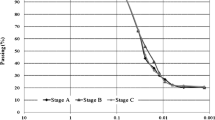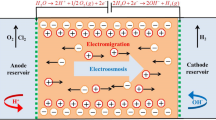Abstract
This study was carried out to investigate the efficacy of electrokinetics to remediate two identical soft kaolinite clay slurries with a water content of 70%. The first slurry was contaminated with copper at a concentration of 150 mg/kg of dry soil and the second with cadmium at the same concentration. The tests were performed in four identical electrokinetic columns (two for the electrokinetics tests and two for control) with a volume capacity of 14 L. An electric field intensity of 140 V/m was applied during 118 h of remediation with the top electrode serving as the anode (+ ve) and the bottom electrode acting as the cathode (− ve). The results showed that electrokinetics removed 2070 mL of water from the soil with copper contamination (compared to only 693 mL in the control test) and 1828 mL of water from the soils with cadmium contamination (compared to 839 mL in the control test). Electrokinetics was successful in removing significant portion of the copper and cadmium from most of the contaminated soil with the highest removal in copper (67%) and in cadmium (89%) in the soil sections near the anode. Electrokinetics was more effective in mobilizing the cadmium in the clay soil as compared to copper. Energy consumption determination revealed that electrokinetic remediation was successful in the removal of copper and cadmium from the section near the anode at rates of 77 and 100 mg/kg per kWh, respectively.








Similar content being viewed by others
Data Availability
The authors declare that (the/all other) data supporting the findings of this study are available within the article.
References
Acar, Y. B., & Alshawabkeh, A. N. (1993). Principles of electrokinetic remediation. Environmental Science and Technology, 27(13), 2638–2647.
Almeira, O. J., Peng, C. S., & Abou-Shady, A. (2012). Simultaneous removal of cadmium from kaolin and catholyte during soil electrokinetic remediation. Desalination, 300, 1–11.
Alshawabkeh, A. N. (2009). Electrokinetic soil remediation: Challenges and opportunities. Separation Science Technology, 44(10), 2171–2187. https://doi.org/10.1080/01496390902976681
ASTM (2007) ASTM D422–63 (2007) e2: Standard test method for particle-size analysis of soils (Withdrawn 2016), ASTM International, West Conshohocken, PA.
ASTM (2014) ASTM D854–14: Standard test methods for specific gravity of soil solids by water pycnometer, ASTM International, West Conshohocken, PA.
ASTM (2017) D4318–17e1: Standard test methods for liquid limit, plastic limit, and plasticity index of soils, ASTM International, West Conshohocken, PA,
ASTM (2017) D2487–17e1: Standard practice for classification of soils for engineering purposes (Unified Soil Classification System), ASTM International, West Conshohocken, PA.
ASTM (2019) D4972 - 19: Standard test methods for pH of soils. ASTM International, West Conshohocken, PA, USA.
Bhargavi, V. L. N., & Sudha, P. N. (2015). Removal of heavy metal ions from soil by electrokinetic assisted phytoremediation method. International Journal Chemical Technology Research, 8, 192–202.
Cameselle, C., & Gouveia, S. (2018). Electrokinetic remediation for the removal of organic contaminants in soils. Current Opinion in Electrochemistry, 11, 41–47.
Cameselle, C., & Reddy, K. R. (2013). Effects of periodic electric potential and electrolyte recirculation on electrochemical remediation of contaminant mixtures in clayey soils. Water Air Soil Pollution, 224(8), 1636. https://doi.org/10.1007/s11270-013-1636-8
Cameselle, C. (2014). Electrokinetic remediation, cost estimation. In: Kreysa G., Ota K., Savinell R.F. (eds) Encyclopedia of applied electrochemistry. Springer, New York, NY. https://doi.org/10.1007/978-1-4419-6996-5_91
Chung, H. I. (2009). Field applications on electrokinetic reactive pile technology for removal of Cu from in-situ and excavated soils. Separation Science and Technology, 44(10), 2341–2353.
Dai, S., Li, Y., Zhou, T., & Zhao, Y. (2017). Reclamation of heavy metals from contaminated soil using organic acid liquid generated from food waste: Removal of Cd, Cu, and Zn, and soil fertility improvement. Environmental Science and Pollution Research, 24, 15260–15269.
Ferreira, A. R., Couto, N., Ribeiro, A. B., et al. (2019). Electrodialytic arsenic removal from bulk and pre-treated soil. Water Air Soil Pollution, 230(4), 78. https://doi.org/10.1007/s11270-019-4116-y
Hanfi, M. Y., Mostafa, M. Y. A., & Zhukovsky, M. V. (2019). Heavy metal contamination in urban surface sediments: Sources, distribution, contamination control, and remediation. Environmental Monitoring Assessment, 192(1), 32. https://doi.org/10.1007/s10661-019-7947-5
Hassan, I. and Mohamedelhassan, E., (2021). Improving the characteristics of a lean clay by electrokinetic treatment. International Journal of Civil Engineering. https://doi.org/10.1007/s40999-021-00604-0
Hassan, I., Mohamedelhassan, E., & Yanful, E. (2015). Solar powered electrokinetic remediation of Cu polluted soil using a novel anode configuration. Electrochimca Acta, 181, 58–67.
Hyldegaard, B. H., & Ottosen, L. M. (2020). Selecting electrode materials and sequence for electrochemical removal of chlorinated ethenes in groundwater. Water Air Soil Pollution, 231(6), 290. https://doi.org/10.1007/s11270-020-04641-8
Jaishankar, M., Tseten, T., Anbalagan, N., Mathew, B. B., & Beeregowda, K. N. (2014). Toxicity, mechanism and health effects of some heavy metals. Interdisciplinary Toxicology, 7, 60–72. https://doi.org/10.2478/intox-2014-0009
Kaonga, C. C., Kosamu, I. B., Lakudzala, D. D., Mbewe, R., Thole, B., & Monjerezi, M. (2017). A review of heavy metals in soil and aquatic systems of urban and semi-urban areas in Malawi with comparisons to other selected countries. African Journal of Environmental Science Technology, 11, 448–460. https://doi.org/10.5897/AJEST2017.2367
Karkush, M. O., & Yassin, S. (2020). Using sustainable material in improvement the geotechnical properties of soft clayey soil. Journal of Engineering Science and Technology, 15(4), 3208–2222.
Ke, X. A., Zhang, F. J., Zhou, Y., Zhang, H. J., Guo, G. L., & Tian, Y. (2020) Removal of Cd, Pb, Zn, Cu in smelter soil by citric acid leaching. Chemosphere, 255, (126690) https://doi.org/10.1016/j.chemosphere.2020.126690
Khafaga, A. F., Abd El-Hack, M. E., Taha, A. E., Elnesr, S. S., & Alagawany, M. (2019). The potential modulatory role of herbal additives against Cd toxicity in human, animal, and poultry: A review. Environmental Science and Pollution Research International, 26(5), 4588–4604. https://doi.org/10.1007/s11356-018-4037-0
Li, P., Lang, M., Wang, X.-X., & Zhang, T.-L. (2016). Sorption and desorption of copper and cadmium in a contaminated soil affected by soil amendments. Clean Soil, Air, Water, 44(11), 1547–1556.
Liu, K. X., Huang, T., Huang, X., Yu, L., Muhammad, F., Jiao, B., & Li, D. (2016). The application of homemade Neosinocalamus affinis AC in electrokinetic removal technology on heavy metal removal from the MSWI fly ash. Science Reports, 6, 39312. https://doi.org/10.1038/srep39312
Liu, J., Zhao, L., Liu, Q., Li, J., Qiao, Z., Sun, P., & Yang, Y. (2021). A critical review on soil washing during soil remediation for heavy metals and organic pollutants. International Journal of Environmental Science and Technology. https://doi.org/10.1007/s13762-021-03144-1
Lynch, R. J., Muntoni, A., Ruggeri, R., & Winfield, K. C. (2007). Preliminary tests of an electrokinetic barrier to prevent heavy metal pollution of soils. Electrochimica Acta, 52, 3432–3440.
Merdoud, O., Cameselle, C., Boulakradeche, M. O., Akretche, D., & E. . (2016). Removal of heavy metals from contaminated soil by electrodialytic remediation enhanced with organic acids. Environmental Science: Processes & Impacts, 11(18), 1440–1448.
Mohamedelhassan, E. (2009). Electrokinetic strengthening of soft clay. Ground Improvement, 162(4), 157–166.
Mohamedelhassan, E., & Shang, J. Q. (2003). Electrokinetics-generated pore fluid and ionic transport in an offshore calcareous soil. Canadian Geotechnical Journal, 40(6), 1185–1199.
Muszynska, E., & Hanus-Fajerska, E. (2015). Why are heavy metal hyperaccumulating plants so amazing. BioTechnologia. Journal of Biotechnology, Computational Biology and Bionanotechnology, 96, 265–271. https://doi.org/10.5114/bta.2015.57730
Ottosen, L. M., Jensen, P. E., Kirkelund, G. M., et al. (2013). Electrodialytic remediation of different heavy metal-polluted soils in suspension. Water Air Soil Pollution, 224, 1707. https://doi.org/10.1007/s11270-013-1707-
Pohanka, M. (2019). Copper and copper nanoparticles toxicity and their impact on basic functions in the body. Bratislava Medical Journal, 120(6), 397–409. https://doi.org/10.4149/BLL-2019065
Weihua, Z., Luwen, Z., Lizhi, T., Rongliang, Q., & Irene, L. (2011). Electro-migration of heavy metals in an aged electroplating contaminated soil affected by the coexisting hexavalent chromium. Chemosphere, 86(8), 809–816. https://doi.org/10.1016/j.chemosphere.2011.11.042
Qi, X., Xu, X., Zhong, C., Jiang, T., Wei, W., & Song, X. (2018). Removal of cadmium and lead from contaminated soils using sophorolipids from fermentation culture of Starmerella bombicola CGMCC 1576 fermentation. International Journal of Environmental Research Public Health, 15(11), 2334.
Ryu, B. G., Park, G.-Y., Yang, J.-W., & Baek, K. (2011). Electrolyte conditioning for electrokinetic remediation of As, Cu, and Pb-contaminated soil. Separation and Purification Technology, 79, 170–176. https://doi.org/10.1016/j.seppur.2011.02.025
Song, Y., Ammami, M. T., Benamar, A., Mezazigh, S., & Wang, H. (2016). Effect of EDTA, EDDS, NTA and citric acid on electrokinetic remediation of As, Cd, Cr, Cu, Ni, Pb and Zn contaminated dredged marine sediment. Environmental Science and Pollution Research, 23, 10577–10586.
Yuan, L., Xu, X., & LI, H., Wang, Q., Wang, N. & Yu, H., . (2017). The influence of macroelements on energy consumption during periodic power electrokinetic remediation of heavy metals contaminated black soil. Electrochimica Acta, 235, 604–612.
Funding
The research is funded by a research grant from the Natural Sciences and Engineering Research Council of Canada (NSERC) awarded for the second author.
Author information
Authors and Affiliations
Corresponding author
Additional information
Publisher's note
Springer Nature remains neutral with regard to jurisdictional claims in published maps and institutional affiliations.
Rights and permissions
About this article
Cite this article
Hassan, I., Mohamedelhassan, E. Efficacy of Electrokinetics in Remediating Soft Clay Slurries Contaminated with Cadmium and Copper. Water Air Soil Pollut 232, 289 (2021). https://doi.org/10.1007/s11270-021-05250-9
Received:
Accepted:
Published:
DOI: https://doi.org/10.1007/s11270-021-05250-9




